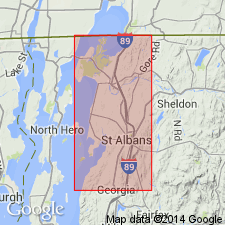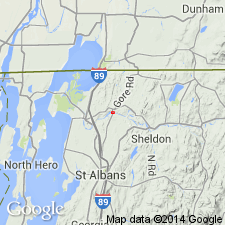
- Usage in publication:
-
- Gorge formation
- Modifications:
-
- Named
- Dominant lithology:
-
- Dolomite
- Limestone
- Slate
- Quartzite
- Conglomerate
- AAPG geologic province:
-
- New England province
Summary:
Named the Gorge formation for Highgate Gorge, Franklin Co., northwestern VT. Lower part consists of (ascending) 26 feet of conglomerate, 15 feet of interbedded massive blue-gray dolomite and intraformational slabby dolomite, 5 feet of gray dolomite (lensoid), 12 to 15 feet of thin-bedded dolomite, limestone, shale, and sandy beds, 10 to 15 feet of conglomerate, 6 feet of sandy dolomite, 6 feet of sandy black slate, 1 foot of small pebble intraformational conglomerate. The upper part consists of 80 feet of massive dolomite and 162 feet of thin-bedded dark blue limestone, magnesian limestone, black slate, quartzite, and intraformational flat-pebble conglomerate of dolomite and limestone pieces, and black dolomitic slate. Unconformably overlies the Parker slate and underlies the Highgate formation. Based on correlation and stratigraphic position, the Gorge is considered of Late Cambrian age.
Source: GNU records (USGS DDS-6; Reston GNULEX).

- Usage in publication:
-
- Gorge Formation
- Modifications:
-
- Age modified
- Biostratigraphic dating
- AAPG geologic province:
-
- New England province
Summary:
Conodont biostratigraphy indicates that the Gorge Formation in VT is of Late Cambrian and Early Ordovician age.
Source: GNU records (USGS DDS-6; Reston GNULEX).
For more information, please contact Nancy Stamm, Geologic Names Committee Secretary.
Asterisk (*) indicates published by U.S. Geological Survey authors.
"No current usage" (†) implies that a name has been abandoned or has fallen into disuse. Former usage and, if known, replacement name given in parentheses ( ).
Slash (/) indicates name conflicts with nomenclatural guidelines (CSN, 1933; ACSN, 1961, 1970; NACSN, 1983, 2005, 2021). May be explained within brackets ([ ]).

